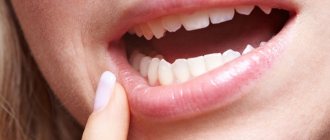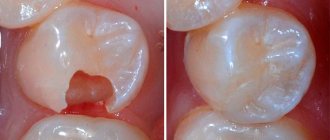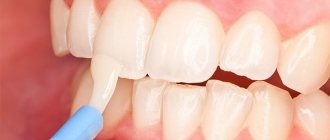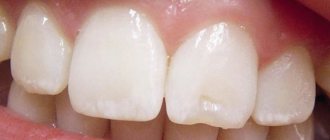What causes damage to tooth enamel?
Thinning tooth enamel causes the inner layer of enamel (dentin) to become exposed. Dentin contains a large number of nerve endings. This is why teeth become sensitive to external irritants, especially hot and cold.
Plus, without good enamel, teeth decay much faster . Bones can regenerate over time, but enamel does not have this ability. For this reason, any crack or small chip has serious consequences.
It is also worth noting that thin enamel is an excellent environment for the development of caries.
Causes of destruction
Tooth enamel is destroyed due to the following factors::
- genetic predisposition;
- problems with the digestive system, which lead to heartburn, vomiting and dry mouth;
- lack of fluoride in enamel;
- poor oral hygiene;
- taking certain types of medications, in particular aspirin or antihistamines;
- teeth grinding;
- insufficient production of saliva - this process leads to the drying out of the oral cavity, as a result of which the infection penetrates the teeth more easily;
- plaque and food debris produce toxins that gradually destroy the protective shell of the teeth;
- excessive consumption of foods that contribute to the destruction of enamel - carbonated drinks, sweet and sour foods;
- using incorrect hygiene products - using pastes with large abrasive particles for too long damages the tooth shell;
- home teeth whitening - not all methods lead to the desired result, and sometimes, on the contrary, they harm the enamel.
We invite you to watch a video about the causes of tooth enamel destruction:
Preventive measures
Certain preventive measures also help strengthen tooth enamel, including:
- maintaining oral hygiene;
- use a medium-hard brush;
- the use of pastes and gels to strengthen enamel;
- consumption of solid raw vegetables and fruits: apples, carrots, cabbage;
- Regular visits to the dentist, who recognizes enamel damage in the initial stages of manifestation of the disorder.
Be attentive to your teeth, and you won’t have to waste time, effort and money on their treatment in the future!
Symptoms
The following signs will indicate that tooth enamel is becoming thinner::
- increased sensitivity of teeth - discomfort is caused by both foods (hot, cold, sour or sweet) and cold air;
- irritation during mechanical action - brushing teeth or chewing food;
- damage to dentin makes the tooth more vulnerable, which is why yellow and black pigmentation often appears on it;
- development of caries cavities;
- the appearance of chips and cracks.
How to recognize the onset of tooth decay in time?
The process of tooth decay usually occurs in stages:
- The supra-root part of the tooth darkens;
- The crown part turns yellow - this is a sign of thinning of the enamel;
- Softened enamel becomes rough;
- Teeth become sensitive to changes in food temperature;
- Cracks and chips appear;
- The shape of the teeth changes.
The cause of tooth decay is inevitably a malocclusion.
If problems arise, measures should be taken in a timely manner. If you have complaints about bleeding gums, soreness and discoloration, you should contact a periodontist. Timely treatment can be a lifesaver for your teeth.
Toothpastes for strengthening
- Splat Biocalcium . The product is produced in Russia. The active component of the paste is calcium. It is obtained in laboratories from eggshells. Calcium helps eliminate microcracks and chips. The sensitivity of teeth is reduced and their structure is restored. The paste helps whiten teeth without the use of aggressive substances. The paste contains no fluoride.
- Sensodyne . The main advantage of the product is its ability to remineralize damaged enamel. The components first restore the tooth shell and then strengthen it. All this is possible thanks to the presence of a special strengthening substance called strontium acetate. It is he who is responsible for reducing sensitivity and protecting nerve channels. The paste also contains fluorides, which strengthen the enamel and block the development of the carious process.
- Rox . Contains calcium glycerophosphate. This component blocks the destruction of the protective layer of enamel. There are also substances that protect against the appearance of tartar and prevent bacteria from multiplying. These are bromeylan and xylitol.
- Silka . Pasta made in Germany. The main active ingredient is sodium fluoride. Vitamin complexes and plant extracts are present in smaller quantities. This composition strengthens not only the enamel, but also the gums, thereby reducing bleeding. Also, after using the paste, inflammatory processes decrease.
- PRESIDENT Sensitive . The pasta is made in Italy. The main substances are calcium hydroxyapatite and sodium fluoride. The paste contains small abrasive substances. Calcium particles are so small that they easily penetrate microcracks, acting as a kind of filling. Regular use of the paste will provide fresh breath and get rid of plaque.
How to strengthen at home using folk remedies?
- Salt solution . It is very simple to prepare - add two teaspoons of salt to a glass of warm water, stir and rinse every night before bed.
- Activated carbon mixture . Crush 3-4 tablets into powder and add water until a thick paste forms. Brush your teeth with a similar product once every seven days.
- Propolis tincture . A tablespoon of tincture is diluted in a glass of warm water. Rinse the mouth with the prepared solution once a day.
- Tea tree oil . Three drops of oil are added to a glass of water. Apply the solution every evening.
- Lemon peel . There are two options for using it. You can simply rub the peel on your teeth, or you can chew it.
We invite you to watch a video on how to strengthen tooth enamel at home:
Methods for strengthening tooth enamel in dentistry
When tooth enamel is weakened, dentists recommend performing procedures aimed at saturating it with the missing chemical elements.
Remineralization
Demineralization - a decrease in the level of calcium and phosphorus in the hard tissues of teeth - is the main reason for the decrease in their strength and increased sensitivity to chemical and thermal irritants. The essence of remineralization is to saturate the surface layer of teeth with phosphorus and calcium. A special composition containing these microelements is applied to the surface of the teeth by application or with the help of trays.
The doctor decides what composition to strengthen the enamel and how long to carry out the procedures based on the condition of the enamel and the age of the patient. The procedure is even used to strengthen children’s teeth and restore the dental surface during or after orthodontic treatment. Remineralization can be prescribed from the age of six.
After restorative therapy, the risk of developing caries, the intensity of fluorosis, hyperesthesia (sensitivity) are reduced, and the microflora of the oral cavity is normalized. An additional advantage of the procedure is the lightening of tooth enamel up to 5 tones.
Fluoridation
In addition to calcium and phosphorus, the composition of hard dental tissues includes fluoride. The level of its concentration affects the strength of the enamel and its ability to absorb calcium.
Deep fluoridation is carried out by a dentist no more than once a year using special preparations for professional use that penetrate deep into the dental tubules. To strengthen tooth enamel at home, gentle compounds are used that act only on the surface. Such procedures can be done monthly.
Dental procedures
- Remineralization . The procedure consists of restoring the mineral composition of the teeth. A special composition is applied to the teeth (usually done using trays) and retained for a certain time. In clinics, the procedure is accompanied by exposure to electrophoresis or ultraviolet light. Procedures last from 5 days to two weeks. Before remineralization, it is imperative to clean your teeth from plaque and stone.
- Fluoridation . This procedure differs from the previous one only in the composition of the medicinal products. The method of application is the same, but in this case fluorine and calcium are present in larger quantities in the preparations.
- Dental restoration . This procedure is resorted to in extreme cases - if the protective shell has completely collapsed and the teeth have already been exposed. In this case, it is necessary to protect the teeth from external irritants. Most often, veneers or lumineers are used for this. Such devices perform several functions at once: improving appearance, straightening teeth and protecting against negative influences.
What does tooth enamel consist of and why does it thin out?
Enamel protects dentin and pulp from injury and the negative effects of bacterial microflora living in the oral cavity, and is the thinnest but strongest layer of the tooth. Its composition is based on minerals (about 95%), a large share of which is calcium and phosphorus. With age, the ratio of organic and inorganic substances changes, and the enamel becomes thinner, weaker and more susceptible to caries.
The rate of destruction of the surface layer of teeth depends on factors related to both heredity and lifestyle, hygiene and nutrition. Often the reason that it begins to break down is due to improper brushing techniques or an incorrectly selected toothbrush.
The hard tissues that make up human teeth are not capable of regenerating, so external help is required to strengthen and restore them. Tooth enamel can be strengthened by undergoing special dental procedures, during which it is saturated with fluoride and calcium. And also with the help of folk remedies and through the constant use of specialized toothpaste.
In addition, you should protect yourself from negative factors that enhance destructive processes. Harmful to enamel are foods and drinks that inhibit the beneficial microflora of the oral cavity:
- Carbonated drinks.
- Sweets.
- Alcohol.
- Seeds and nuts.
- Acidic foods, such as citrus juices.
The harm of citrus juices can be minimized by using a straw for drinking, which reduces the area of contact of the acid with the surface of the teeth.
Food
To improve the condition of your teeth, include the following foods in your diet:
- Dairy products - they contain a large amount of calcium, which promotes the remineralization of enamel. In addition, milk promotes the production of saliva. If you are allergic to lactose, you can drink soy milk.
- Strawberry . The berry contains a lot of vitamin C and antioxidants. The product not only improves the condition of tooth enamel, but also the entire oral cavity. Strawberries contain malic acid, which cleanses the surface of teeth and has a mild analgesic effect.
- Celery . The high fiber content promotes active cleansing of the enamel. Slowly chewing celery will provide not only cleansing, but also a good massage of the gums.
- Sesame . It contains abrasive particles that clean the surface of the teeth and protect them from the development of bacteria. It also contains a lot of calcium.
- Parsley . Greens have a powerful antibacterial effect. It can be used in salads, or you can simply chew it.
- Green tea (preferably loose leaf). Contains large amounts of fluoride and antioxidants.
How to strengthen teeth enamel: 5 reliable ways
If you want to strengthen your enamel, the following methods will come to your aid and must be used in combination:
Proper nutrition
Include the following foods in your diet that help strengthen your teeth:
- Dairy
Milk, cheese, kefir, and yogurt contain a lot of phosphorus and calcium, which ensure remineralization of enamel. In addition, dairy products contribute to the normal production of saliva, which has a protective function. For people with lactose intolerance, calcium-fortified soy milk is suitable.
Dairy products are a source of calcium, which is certainly good for tooth enamel.
- Strawberry
Contains a lot of vitamin C and antioxidants. Helps keep both teeth and oral mucosa in order. Strawberries contain malic acid, which naturally cleans the surface of teeth from plaque and also has a mild whitening effect.
Who would have thought, but strawberries perfectly cleanse teeth of plaque, thereby strengthening tooth enamel
- Celery
Contains a large amount of fiber, which makes it possible to effectively clean the surface of teeth from plaque. It is very useful to chew celery slowly, this way you will not only clean your teeth, but also provide an excellent massage to your gums, as well as stimulate saliva production.
- Vitamin D
This element plays an important role in the regulation of proteins that create tooth enamel. This is fish, fish oil, egg yolk.
- Sesame
Contains abrasive particles that help clean enamel from bacteria. Sesame contains a lot of calcium. You can add a handful of sesame seeds to the salad, it is very tasty.
- Parsley
This green has powerful antibacterial properties, preventing the development of infection in the oral cavity. You can add it to salads, or you can just chew it.
- Vitamin K
Promotes bone growth and absorption of nutrients. Helps strengthen teeth in combination with vitamin D (cabbage, broccoli, egg yolk, hard cheese).
- Tea
Tea leaves contain large amounts of antioxidants and fluoride. Green tea contains a special substance - polyphenol, which prevents plaque from attaching to the surface of the teeth.
Fluoridation
Strengthening enamel involves saturating it with useful microelements. For these purposes, several methods are used in dentistry:
Teeth absorb fluoride through their surface, which is why to saturate the enamel with fluoride, various gels and pastes containing this substance are applied to the teeth. Special mouth guards are also used, which are filled with a special fluoride-containing gel. Such devices are worn at night.
In addition, special applications are used: individual wax casts are made. They are filled with a substance containing fluoride and applied to the teeth.
There is a special technology that allows you to restore teeth with cracks and chips. For such purposes, materials are used that are most similar in composition to natural teeth. They connect to the tooth at the cellular level, penetrating the enamel and filling all the voids.
Fluoridation of teeth before and after photos
Remineralization
To restore enamel in this case, substances are used that closely resemble the composition of saliva. Stay tuned, a full article on remineralization will be published soon. Read the separate article here.
Folk remedies
You can strengthen the enamel using proven folk methods:
- rinse your mouth with saline solution before going to bed,
- slowly chew the white pulp of the lemon peel,
- Brush your teeth once a week with a mixture of activated carbon and water,
- massage your gums with a soft brush, this will ensure a rush of blood to the mucous membrane,
- chew carrots, apples, celery, these products naturally clean the surface of your teeth from plaque,
- rinse your mouth with a solution of propolis tincture and warm water,
- Have your teeth professionally cleaned 1-2 times a year,
- use floss (dental floss),
- rinse your mouth with water and tea tree oil (3 drops of oil per glass of water),
- drink enough clean water.
Correct prevention
- Brush your teeth regularly with a quality toothpaste
- don't indulge in sweets
- Don't overdo it with whitening toothpastes
- treat dental diseases in a timely manner
- eat dairy and dairy products
- limit your consumption of coffee, tea
- quit smoking.
Vitamins
To strengthen the protective shell of teeth, dentists recommend taking the following vitamins:
- Vitamin A . Particularly necessary for healthy gums. And gum disease leads to dry mouth and bleeding, which are prerequisites for thinning tooth enamel.
- B vitamins . The most beneficial vitamins for teeth and gums are B1, B2, B6 and B12.
- Vitamin C . Lack of ascorbic acid leads to enamel deterioration. To avoid gum pathology, you need to take ascorbic acid every day.
- Vitamin D . Without it, calcium absorption is impossible. To produce the vitamin, walk in the sun as much as possible.
- Calcium . The element is part of bone tissue, so its deficiency is especially acute.
What you need to know about tooth enamel?
There are many elements inside the tooth that are protected by the enamel. And if it is damaged, it can lead to destruction and damage to the deep parts of the dental unit. Caries may develop.
Not everyone's tooth enamel is the same in density and mineralization. These characteristics also change with age. Gradually, the lateral incisors are most at risk; only with age do the molars suffer.
Enamel is not bone tissue, so it is not able to regenerate. It contains no living cells or organisms. That is why it is so important to strengthen – and in a timely manner – the enamel of teeth. And this process should be approached with all responsibility, because the consequences can be quite dire.
Gels
- ROCS MEDICAL MINERALS . Rox gel promotes enamel remineralization. After using this gel, the tooth shell is saturated with elements that are as close as possible to phosphorus, calcium and magnesium ions. After applying the gel, a protective coating is formed on the teeth, and the microflora of the oral cavity is normalized.
- LACALUT FLUOR GEL . The functions of this gel are to slow down age-related thinning of enamel. It features an innovative composition: amino fluoride and sodium fluoride. This composition creates a protective layer on the inner and outer surfaces of the teeth.
- GC TOOTH MOUSSE . The product is available in the form of a mousse. Saliva is a catalyst for the drug, so it is not recommended to swallow saliva for 7-10 minutes after applying it. In addition to strengthening the enamel, the mousse has an antiseptic effect.
- PROTEFIX DENTAL GEL . A complex drug that helps restore thinned enamel and prevent its further destruction. Acts as an antiseptic and anesthetic.
Treatment methods for enamel hypoplasia in children
If white spots on teeth are invisible to others, they are usually not removed. But the enamel, severely affected by the disease, ceases to protect the tooth tissue, resulting in complications - increased wear of teeth, destruction of dentin up to the loss of teeth, and the appearance of malocclusions. To prevent this, timely therapy is necessary.
Procedures for the treatment of enamel hypopalsia in children:
Prevention
To avoid thinning tooth enamel, follow these simple rules:
- maintain oral hygiene and use only high-quality products;
- limit your consumption of sweets;
- do not get carried away with toothpastes with a whitening effect;
- treat dental ailments in a timely manner;
- consume more dairy products;
- reduce your consumption of coffee and black tea;
- stop smoking.
Recovery Tips for Children
- First you need to adjust your diet, which should include fruits, vegetables, meat, fish and dairy products.
- Maintain good oral hygiene by brushing your teeth twice a day and rinsing your mouth after every meal (if possible).
- Visit your dentist regularly.
- Protect your child from viruses and infections.
Tooth enamel is the key to a beautiful and healthy smile . However, if the enamel is destroyed too often, it is worth understanding the reasons for this negative process. For example, if the enamel is destroyed due to an incorrect bite, it is necessary to correct it.
Causes of enamel deterioration
Several factors (external and internal) are identified that can provoke deterioration of the enamel. Depending on the nature of the origin, external factors are also classified by specialists. Temperature changes often cause destruction of the protective layer. It is the contrast that leads to the formation of cracks. And this already opens up access for pathogenic microflora to the deep layers of the tooth. Chemical factors are considered the most dangerous. They have a very aggressive effect on the enamel and lead to rapid destruction. Mechanical stress leads to deformation and thinning of the protective layer. This may include blows, excessive pressure, or chewing too hard food. Poor or lack of oral hygiene practices are considered to be major factors.
Internal causes are due to general health and nutritional disorders. Common factors include malocclusion. If this problem is not solved, it will certainly provoke disturbances in the structure of the enamel.











